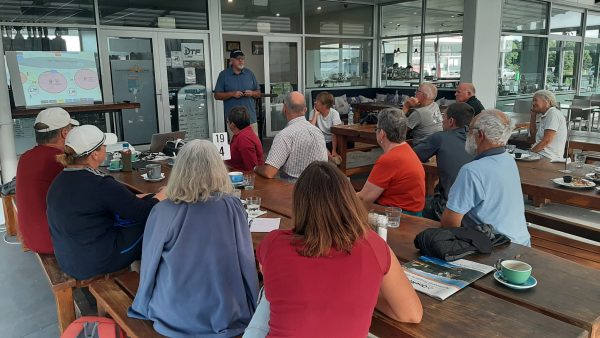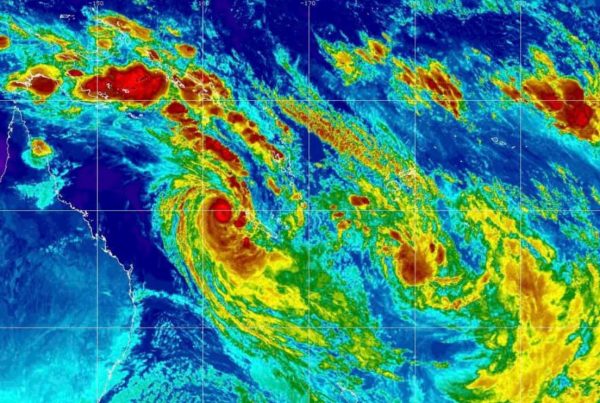OCEAN TACTICS PACIFIC WEATHER ROUTING
OCEAN TACTICS | PACIFIC WEATHER ROUTING 💨

John Martin principal of Ocean Tactics has been assisting skippers with weather and passage planning in the Pacific for many years is now an official sponsor of the Pacific Posse.

“Departure Planning is an essential first step in passage comfort and safety and a couple of days can make the world of difference. Once out there it’s all about, Putting the Boat in the Right Place, to take best advantage of the weather”
OFFSHORE WEATHER ROUTING
Pacific Passage Tactics
This allows us to get to know you and your vessel and is a necessary part of all Ocean Tactics engagements. During the lead up to the passage we’ll discuss Comfort Levels for Wind and Wave, Vessel Characteristics and Conditions to expect on passage.
Passage Tactics also includes discussion briefings via Line, WhatsApp or Messenger just prior to departure to give you a full understanding of what to expect and detail factors that may influence your tactics on passage.
Pacific Departure Planning
Picking the right departure goes a long way to having a good passage. We’ll work with you to pick the best weather window for any specified passage based on your personal parameters and that of the vessel as per the answers given when you sign up.
Pacific Passage Management
Possibly the most important part of the service for a safe and comfortable passage. We make sure you put the vessel in the right place to best take advantage of the weather that’s coming as the passage proceeds. Updates are sent via email and or WhatsApp.

SOUTH PACIFIC POSSE DEAL
CONTACT US
Email
admin@coastalandoffshorecruising.com
Contact
WhatsApp / Tel +64 27 242 1088
Home
The Good Ship ‘Windflower’

Pre Passage Check List and Crew Familiarization
• Lifejackets Safety Harnesses & Tethers
• EBIRB (Know how to activate it)
• Grab Bag (see “What’s in a Grab Bag” below.)
• Life raft and how to deploy, is it’s certification current and is there any damage to the case
• Emergency Steering (how to set up. Is there a special tool to get access to the steering quadrant? Where is it?)
• Flashlights (keep at least one on deck at night)
• If USB charged have you the correct charging cable
• Spare Batteries of all sizes
• Tools
• Fire extinguishers/ Fire Blanket
• Duct Tape/ Waterproof tape/Anti Chafe Tape
• Manual Bilge Pump Handles
• Fog Horn
• First Aid Kit (See “What’s in a Med Kit below”)
• Spare Oil and Filters, Raw water impellor
• Extra lashings and tie downs
• Every Seacock (or at least know every location) or a couple of Forespar StaPlug™ Hole Plug Bungs
• Wooden Plugs & Hammer
• Engine Inlet and strainer: (Know how to clear the strainer)
• Engine – on startup is cooling water coming out exhaust
• Check Engine Fluids (Oil/Transmission)
• How do the belts look? Do you have spares
• Check liquid in the batteries. Check batteries for shape/ Bulging
• Do you have spare filters and impellers?
• Spare Jerry Jugs of fuel
• Check fluid level in any hydraulics, Steering, Auto Pilot ram etc spare fluid.
ON DECK
• A Knife
• Check Turnbuckles, are they wire seized or split pinned
• Check for chafe in furling return lines.
• Check all Halyards are clear and secure.
• Jack line in place and tight (see article “To tether or not?”)
• How to launch the MOB recovery and how the system works
• Make sure the anchor is very secure, but know how to deploy it quickly in an emergency.
• Never put the main anchor in the anchor locker
• Check Running Lights
• Check Compass Light
• (Do you have a backup light for the compass light?)
• Flashlight on deck at night.
• MOB Dan Buoy if manual, test. If Jonbuoy type with a gas canister check if in survey
• Do you have emergency Nav Lights, check batteries
• Check all wind gear, sounders, plotters are working correctly
• If you have wind self steering is it fully set up checked and functioning properly
What you should know how to do (crew)
• Start (Stop) and operate the main engine
• Reef the sails
• Tack and Gybe
• Rig Jack lines
• Understand the Auto Pilot ( See Skippers Watch rules for what you can and CANNOT do)
• Understand the Electrical Panel
• Operate the VHF, Sat comms or SSB in an emergency.
• Operate Bilge pumps (both electrical and Manual)
• Garbage Plan – What goes where (Besides an oil pollution placard many boats also require a garbage placard noting what can and what cannot be thrown overboard).
• Boom Preventer
• Release halyards
Cheat Sheets
Prepare Cheat Sheets
• Watch Rules
• Fire Aboard, including positions of Extinguishers and Fire Blankets
• MOB
• Watch Schedule and Responsibilities of all crew, chores schedule.
• Reefing, Gybing, Tacking.
• Storage, where to find things. Include a plan of the boat with storage areas marked A-Z
What to look out for
Each other
• The boom (Head injuries and falls are the two main causes of injury)
• Tripping on deck (one hand for you and one for the boat, like climbing, three points of contact and ALWAYS clip on).
• Don’t block the helm when docking, underway in port or near busy channels
• Placing things like open drinks on the counter.
• Know not to turn the battery switch off with the engine is running.
• Don’t be afraid to tell the helmsman about anything ahead (Lobster pots,
floating logs) or coming up from behind (faster/bigger boats).
• When off watch make sure you get enough rest.
• Make sure to take your seasickness medicine if you are prone.
• Clean up after yourself in the head and galley.
• Make sure to turn off the propane safety switch after using the stove.
• If the boat policy is to keep the main water panel switch off when not in use, make sure it is off.
Grab Bag Contents
Make sure your 406 EPIRB is GPS capable! This will ensure a much faster location and therefore recovery by RCC (Rescue Coordination Center).
Semi waterproof bag, preferably with flotation.
Water proof bag with:
• Passports, Money, Credit Cards
• Boat papers, Clearance Papers
• Cell phone, Hand held GPS + spare batteries
• Ocean Chart.
• 2x Travelers towels
• Sea sick pills, Any crew medication.
• Flares:- Hand held Orange 4x, Red Parachute 4x, dye marker 1x
• Hand held VHF waterproof, Spare Batteries
• Torch, Spare batteries, spare bulb.
• 406 Epirb Basic first aid kit, sea sick pills.
• Water, usually the packet type (keep a ¾ filled 20lt container on deck with a length of line attached with a clip on the end)
• Basic food, lunch bars, barley sugars, be aware some foods will make you thirsty.
• Packet electrolytes
• Survival blanket.
• Strobe light Anything else you feel you may need
• If you need readers put a pair in a solid glasses case
Tips for a safe passage
• Take the time to prepare your boat well. Work with your safety inspector or use the C&OC Safety Checklist Linked Below.
• Plan your passage in advance, don’t try and do it on the fly. Have a back up route and destination in case of emergency.
• Make regular radio skeds, email reports or use PredictWind tracking to advise a shore contact of your plans, destination, position and ETA.
• Prepare your crew. Practice sail work, explain the boat’s systems and talk about safety procedures and where to find everything.
• Check if your crew is on any medication, if they get seasick they wont be able to hold down their medication
• If any of your crew are the least susceptible to sea sickness, have them start taking something for it, BEFORE you set sail.
• Have a grab bag handy at the foot of the companionway in case of emergency.
• Set up a watch system. Whether it’s two, three or more crew, set up a watch system so everyone knows what they are expected to do. Always keep a good lookout.
• Set up a schedule for chores and make sure everyone has their fair share. Leaving all the cooking and cleaning up to the misses is one sure way to have a grumpy partner.
• Pre-cook some passage meals BEFORE you leave, one pot meals are best and where possible have them pre-frozen ashore.
• Make a box full of sandwiches to have available for the crew whenever they are hungry.
• Have lots of high energy snacks on hand.
• A well fed and rested crew is a happy crew.
• Reef down early, it’s easier and safer. It’s a good idea to reef down before dusk if the forecast is even a bit uncertain.
• Have a daily check around the boat for chafe and things that can come undone, like shackles etc.
• Most important of all, keep the skipper happy. Remember he or she takes ALL the responsibility and a tired skipper is more likely to make mistakes.
• To the skipper, remember you are the boss but also remember what happened to Captain Bligh
